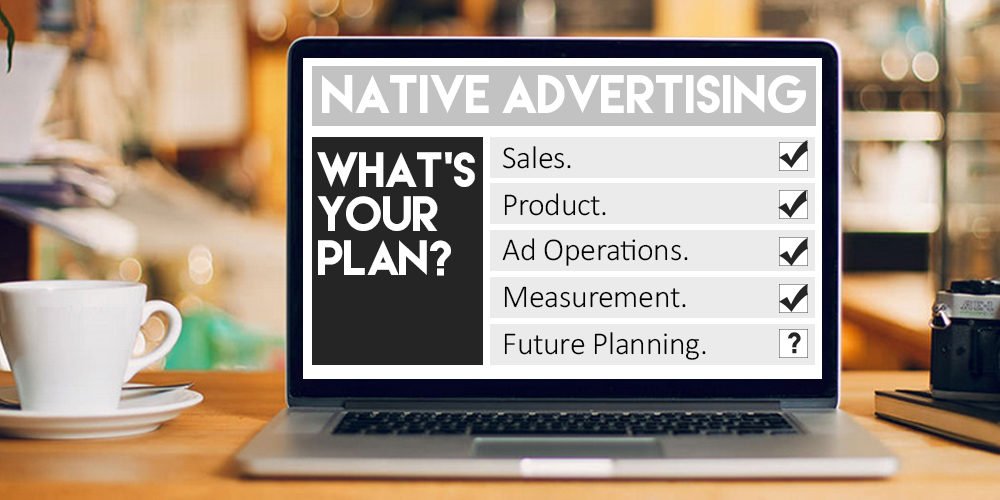Publishers: 5 Considerations for your Native Advertising Strategy

In today’s ever evolving ad marketplace with razor thin margins, publishers are constantly pressed to find the best short term and long term monetization opportunities. Native advertising continues to provide accretive revenue opportunities to large and small premium publishers. According to a study by Hexagram””62% of publishers have utilized some kind of native advertising and the revenue continues to grow exponentially year over year (BIA Kelsey). Recently, New York Times reported a 16.5% growth in digital ad revenue””much of which was driven by native advertising. Being that native advertising is relatively young and there are already over 50 companies dedicated to providing technology and sales, it can be extremely difficult for publishers to plan and choose a long-term native advertising strategy. It’s important to start (or re-evaluate) this process by asking yourself 5 initial questions:
Sales: What is the strongest Native Advertising Sales Strategy?
It is important to determine your ability to sell against the native ad inventory, now and in the future. Premium publishers with direct sales teams often sell a majority of their domestic inventory, although experience difficulty filling internationally. Publishers who rely on programmatic sales need to research the best options to find multiple buyers competing for programmatic native inventory. The appropriate blend of direct sales, Native Ad networks, premium programmatic and Native RTB will depend on the pricing, types of content, audiences and Native ad formats which make up your proposition. A combination of sales strategies is likely to provide optimal revenues.
Product: What are the different Native Ad formats available and how do they fit with my site?
One of the many advantages to native advertising is the opportunity to create bespoke units that fit within the look and feel of the site, across all devices. The IAB defines the goal of native advertising as the delivery of “paid ads that are so cohesive with the page content, assimilated into the design, and consistent with the platform behavior that the viewer simply feels that they belong”. While custom look and feel is essential, native advertising formats fit broadly into 6 categories, as defined by the Native Ad Playbook. Selecting the formats most suited to your site content, design and audience is a key consideration. Understanding which formats will hit your advertiser KPIs and enable long term success working with direct sales, networks and programmatic is also fundamental for success. Proper disclosure continues to be defined; creative and trading standardization is soon to come. Product teams need to pay attention to industry standards and determine how their site design will adopt these units on a regular basis.
Ad Operations: How can I maximize yield and minimize heavy-lifting?
As with all digital media units (display, video, mobile, etc.), native advertising has started out with a number of companies giving publishers valuable options to integrate, and like the other advertising units, the early stages have seen closed platforms and fragmentation. As the industry evolves and demands efficiency, publishers need to find the best solution to optimize for both direct and programmatic sales while reducing workload on their ad operations teams. While formulating your strategy, look to understand how different native formats and campaigns are set up, and how you could maximize the value of your inventory globally through real time ad serving and yield management tools.
Measurement: What KPIs are most important for Native Ads and how can I test efficiently?
Different campaigns and buyers will utilize specific placements and unit formats to reach Brand or Direct Response KPIs. Sponsored content, Social, Video and Search budgets are great demand sources that fit well with native advertising. Each buyer will judge performance differently, with metrics ranging from viewability, CTR, video and content engagement, social sharing and conversion to leads or sales. Once publishers integrate their native solution, regular testing and feedback is essential to reach various user goals and campaign KPIs. Proper formatting, cross device testing, page load time, bounce rates and search repercussions are important aspects to review. Creating in-house solutions can be taxing on the ad operations team and expensive over time. Determining the best fit of a native ad platform for your testing and measurement needs will help the evaluation and growth process.
Future planning: What should I expect over the evolution of native advertising?
As the fragmentation and closed environments in native advertising continue to be challenged by publishers, expect growth and openness to promote efficiency. Disruption by industry leaders and startups will allow the market to grow at consistently strong rates for all the publishers who think ahead. Being nimble and investing in frequent education are necessary. Future forecasting will help determine which in-house resources to utilize and which technologies to implement. A solid approach taken by many of the leading first movers is to appoint a Native Advertising “cheerleader”, or to work with multi-discipline partners; both of whom can break down silos across your business and the Native Ad landscape. The ultimate value from a Native strategy can be realized only when product, editorial, sales, operations and business partners combine to deliver a finessed and dynamic solution.
The future is bright; native advertising is going to continue to grow. Publishers will need to adjust to take advantage of the exciting and lucrative opportunities. As with any emerging digital format, there will be constant industry disruption and improvement; being aware of the basics and future innovation will help you properly plan a long-term strategy.





